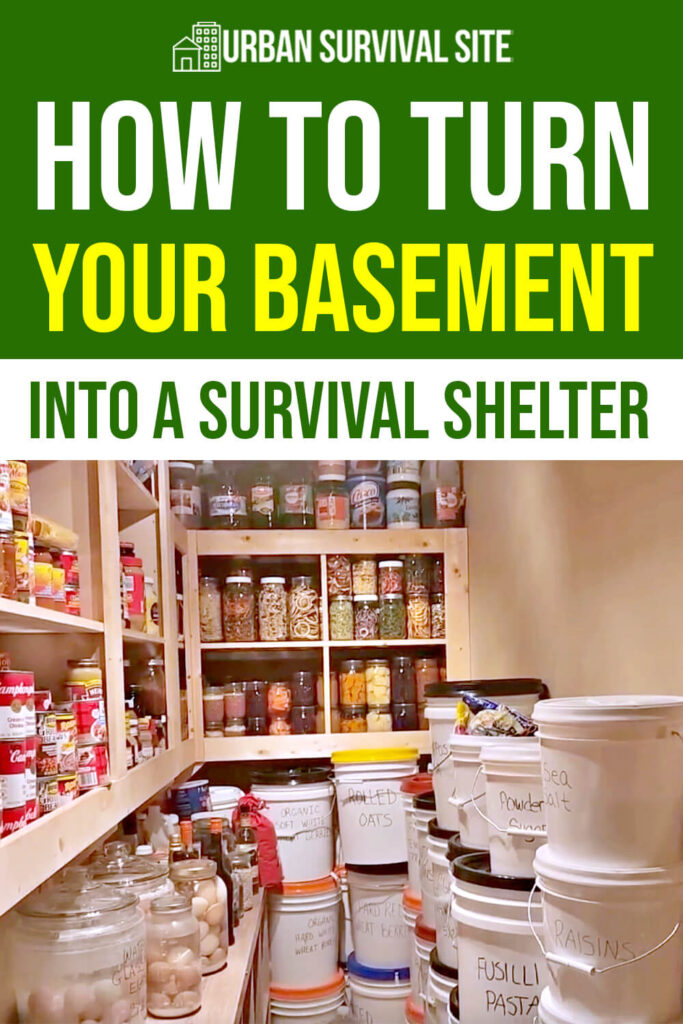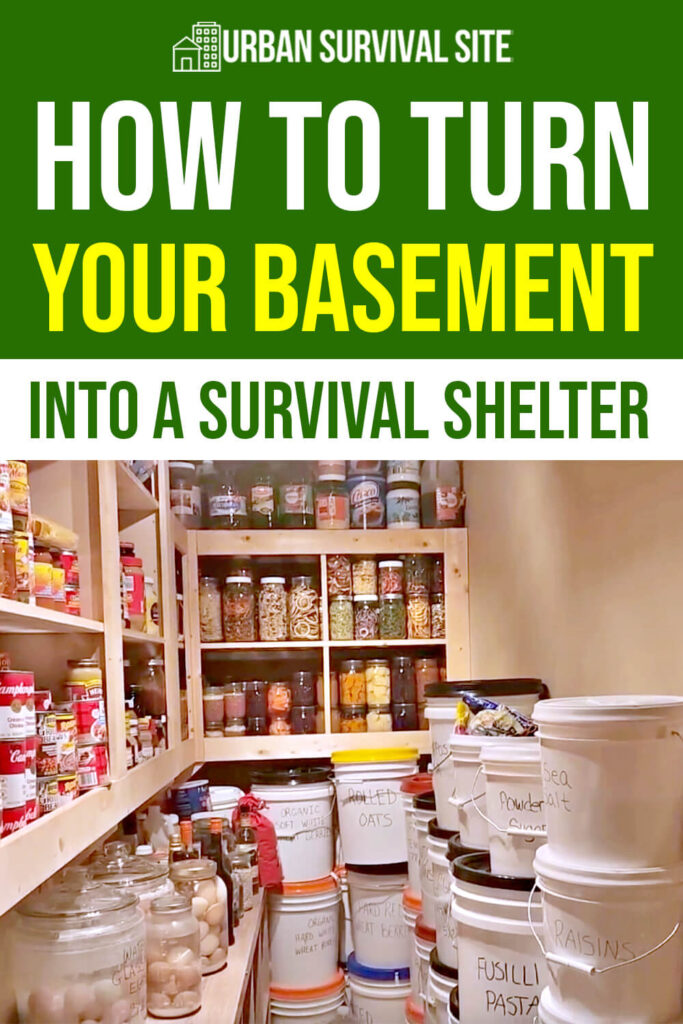

Estimated reading time: 8 minutes
It has now become impossible to ignore. We all need to be better at taking care of ourselves and the people we love. The threat level all over the world has changed and everyone is seeing it. Not everyone knows how to deal with it.
While there is enough creeping collapse around to motivate all of us to prep a little harder, are you motivated enough to create a real survival shelter? The doomsday bunker is a pipe dream for most, even on a handsome salary, you are talking around $400 per square foot for a bunker build these days.
Article continues below.
However, some do have an underground refuge already. Yea, it’s probably musky, maybe even a little damp at times, but your home basement has tremendous potential when it comes to being a survival shelter.
One of the biggest perks is that it is largely surrounded by dirt on all sides but one. That means it can protect you from things like stray gunfire, some natural disasters and even radioactive fallout! Assuming it has a house still sitting over top of it. That’s a good start.
Let’s look at how to turn your basement into a survival shelter.
Want to save this post for later? Click Here to Pin It On Pinterest!
Layout
One of the first things to consider is how you will layout your survival shelter. What are you looking to include? The basement survival shelter is going to require some things if you hope to be down there for any substantial amount of time.
Of course, the degree to which you outfit your survival shelter, beyond the necessities, is completely up to you. You can go as far as your imagination, or your wildest dreams would allow.
Resting / Sleeping Area
No one wants to spend hours or even days with only the option of standing or sitting on the ground. Sleeping on the ground is an even worse prospect. So, your basement survival shelter needs to have some kind of resting/sleeping area. You can designate one area to do both things, or you can create an area with a couch and an area with cots or beds.
These areas do not have to be luxury outfits. A couple of futons might take care of your family’s needs. It could even be as simple as everyone getting their own cot both to sit and sleep on.
Food Prep
Food safety is a real thing and pathogens that you ingest can make you sick whether you are dealing with a disaster scenario or not. You need a designated food prep area that is kept clean so that you can either heat food up or prepare food from scratch in an environment that will allow you and your family to eat well and not contract food borne illnesses.
A table designated for food prep that is kept clean, a water source that is safe, and some cookery that is kept in a clean environment will all help you when it comes to proper food prep. This can all be a single tub that remains closed and filled with your food prep items when they are not in use.
Bathroom
A bathroom can mean a lot of different things, but you are most certainly going to need, at least, a toilet and a way to wash hands. Composting toilets might be the answer but eventually they need to be dumped. If you are stuck in the basement shelter for longer than a couple of weeks, it might become a problem.
Something as simple as a couple water bricks or large water cubes filled with potable water can be great for washing hands. Set up a bucket beneath where you wash your hands and harvest that grey water for cleaning other areas of the survival shelter.
Infirmary
What happens when someone in your shelter falls ill? Should they just lay ill on a cot in the resting area? A much better plan would involve sectioning off a small area, preferably with its own bathroom, where the person who is sick can be treated and kept away from the family.
This separate area will also help when they are trying to rest to get back to health.
Common Area
Passing time is what will dominate your days in a survival shelter. There will not be a ton of objectives for a whole family each day. Instead, you will have lots of time to simply wait for the disaster or other danger to pass.
Having a common area gives you a place to gather. It gives you a place to play board games, talk, make plans, and do all the things you normally do in the living room. If you are tight on space in the basement you can simply turn your rest area into your common area once everyone is up for the day.
Concealment
Are you going to hide this location from those who might come to visit your home? In some cases, a renovated basement can be a very popular gathering place. If you invite people into your basement/survival headquarters, then they are going to realize what is going on down there.
If OPSEC is more of a priority for you then you should consider a false wall or at least creating a separate room in the basement that hides your survival shelter from everyone. Even if you intend to use the entire space, you could store everything that will turn the space into a survival shelter in a separate room in the basement.
Materials
One of the ways you can create an effective basement survival shelter is to divide your basement into sections. This can be done using a variety of materials, the most common material is dry wall. Another consideration is sandwiching ¼ inch metal sheeting between two pieces of dry wall and giving your family even greater protection.
Radiation shielding materials could be another thing to consider. A very cheap and affordable shielding material is water. You can store water in something like water bricks and create a shelter from radiation in your basement. This can be a small area by stacking water cubes or water bricks. Create a simple roof by placing plywood on top of the water brick walls and then topping the plywood with more water jugs or containers.
Basement radiation shielding and building a nuclear safe basement shelter is well outlined in a book called Nuclear War Survival Skills by Cresson Kearny. There are even some YouTube videos of him up from a VHS that was released over 30 years ago! They are packed with information.
Essentials
Survival essentials in your shelter should be the same as survival essentials above ground. You are going to need everything down in your basement survival shelter that you would need above ground.
Another important essential is warmth. You are going to be living underground so staying warm is going to be important. You might also be out of reach of your home heating system. You do not want to start a fire or even run a propane heater in your basement survival shelter unless it has great ventilation.
Escape
No survivalist is going to like the idea of entering a room that has one way in and one way out. It is very important that you figure out how to create an alternate means of escape from your basement survival shelter.
This could be a basement window that opens to the world, or it can be something like a tunnel that takes more work to bring to life. Some kind of escape hatch or exit strategy is as important to your survival as building the shelter itself. You do not want this shelter to become a coffin.
Final Thoughts
An underground survival bunker made of high-quality steel and thick concrete is just not an option for most people. The price tag is far too high for something that would comfortably fit their family. Turning your basement into a survival shelter is the next best option.
Creating a layout that best serves your needs and outfitting that shelter with the essentials gives you a serious advantage in a disaster or emergency. You have a shelter in place location that is designed to house your family and sustain them.
Our basic layout and amenities are enough to keep a family going. Of course, you can add a gym, hydroponics room, classroom, and whatever else your family desires.
Like this post? Don’t Forget to Pin It On Pinterest!


